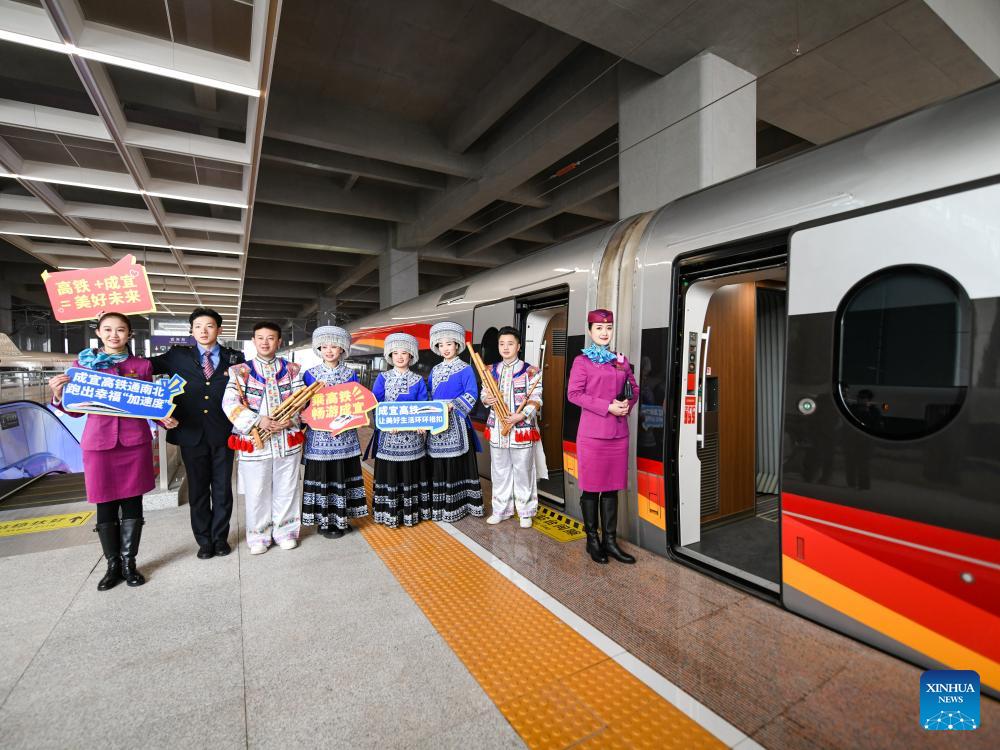
 0 Comment(s)
0 Comment(s) Print
Print E-mail China Daily, December 27, 2023
E-mail China Daily, December 27, 2023Three new high-speed train routes became operational on Tuesday, promoting social and economic development, improving the quality of people's lives and showcasing China's expertise in building high-speed railways in varied and difficult terrain, according to the operator, China State Railway Group.
A sleek new bullet train tore through the rugged terrain of southwestern China's Sichuan province at 350 kilometers per hour on Tuesday, completing a high-speed loop in the southern part of the province.

Crew members and local people pose for photos marking the operation of the Chengdu-Zigong-Yibin high-speed railway on the platform of the Yibin railway station in Yibin, southwest China's Sichuan Province, Dec. 26, 2023. [Photo/Xinhua]
The 261-km line will boost tourism, linking the provincial capital of Chengdu with Zigong, which is famed for its dinosaur fossils, and the white spirits brewing city of Yibin.
In the Guangdong-Hong Kong-Macao Greater Bay Area of southern China, another high-speed route, designed for speeds up to 350 km/h, also began operations on Tuesday.
The 162-km line connecting Shantou and Shanwei in Guangdong province is significant as a coastal route within China's expansive high-speed rail network.
On Tuesday, a substantial section of the line, linking Shantou South with Shanwei, was inaugurated. The final 20 km of the entire route, incorporating an undersea tunnel in Shantou Coastal Bay, is currently under construction. The timetable for its full opening has not been undisclosed.
The third high-speed rail line inaugurated on Tuesday is located in East China's Fujian province. The 92-km line, designed for speeds up to 250 km/h, connects Longyan and Wuping in Fujian. It is a pivotal segment of a larger railway network linking Fujian with Guangdong.
The three lines, though located in different parts of China, all involved construction under challenging conditions.
According to China State Railway Group, the country now has trains running at the highest commercial speeds and boasts the greatest variety of operational scenarios, thus transforming the nation from a follower of high-speed rail development to a true leader in technologies.
China has developed the most comprehensive technologies and gained the richest railway management experience and operational know-how in the world, according to the company.
Zhao Xianghong, deputy director of the science, technology and information research institute of the China Academy of Railway Sciences, said, "China is a world leader in some aspects of high-speed railway development."
In Sichuan, the engineering feat involved tackling the notoriously challenging topography, featuring treacherous mountains, deep valleys and snaking rivers. As Tang Dynasty poet Li Bai once wrote, traversing Sichuan's roads was akin to "scaling the heavens".
But engineers conquered the terrain, building 231 bridges and 29 tunnels along the new line, surpassing past global challenges in high-speed rail construction in the mountains, China State Railway Group said.
In Fujian, the new line passes through a national park, along gas pipelines and through the karst area, which made construction challenging. Engineers tackled the problems by adopting innovative methods, said Li Hongbin, a senior engineer at China Railway Design Corp.
Tunnels and bridges account for about 83 percent of the newly opened section, he said.
The construction of the line in Guangdong also presented challenges due to the coastal environment, characterized by high salinity and humidity. Overcoming these difficulties in the complex hydrogeological setting was crucial. Technical hurdles were addressed through the construction of key infrastructure elements, including the Aojiang River Mega Bridge and the Huilai Tunnel, according to China State Railway Group.
The expanding network of China's high-speed railway has greatly benefited people living along the route. Luo Dan, a Chengdu native, is planning a holiday by train over the New Year.
"The new line in Sichuan forms a high-speed loop linking several tourism attractions in the province, such as Zigong and Leshan. I won't be driving to the places, since the train service is so fast and convenient now," said the 33-year-old.
Four trains will run daily on the route starting on Jan 1, according to China State Railway Group.